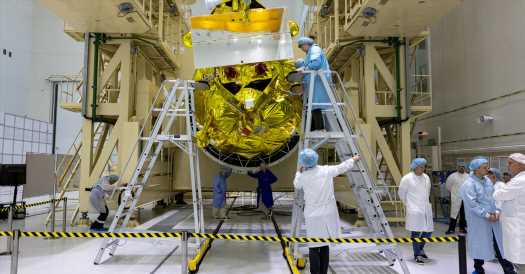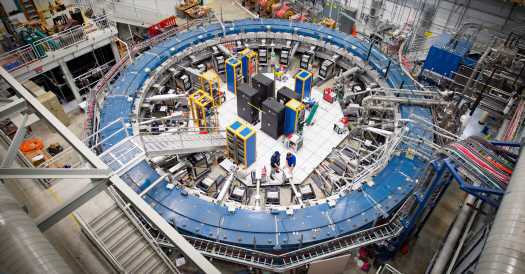Russia is going back to the moon too.
For the first time since the space race with the United States in the 1960s and 1970s, Russia is set to launch a modest-size robotic lander, Luna-25, that will be headed to the moon’s south polar region. The mission has been in development for years before Russia invaded Ukraine, but is also occurring at a moment when President Vladimir V. Putin is looking to space as one way to signal Russia’s return to great-power status.
When is the launch and how can I watch it?
Launch is scheduled for Thursday at 7:10 p.m. Eastern time from Vostochny, a spaceport in the far eastern part of Russia. (It will be Friday morning in Russia, 9:10 a.m. at Vostochny and 2:10 a.m. in Moscow.)
The Russian television network RT will be streaming coverage of the launch beginning at 6 p.m. Eastern, as will Roscosmos, the Russia space agency, on its YouTube channel.
Why is Russia going to the moon?
After the success of NASA’s Apollo moon landings from 1969 through 1972, the world’s space agencies largely lost interest in the moon. Russia completed several robotic landings after the Apollo program’s conclusion, ending with the Luna-24 mission in 1976.
In the decades that followed, attention shifted to more distant destinations in the solar system. But the discovery of water ice in the shadowed craters in the moon’s polar regions has resurrected interest.
Russia has been attempting to revive its lunar program for the last quarter-century, and Russian officials have talked of setting sending Russian astronauts there too.
“The architecture of the lander is very similar to what the Soviet Union used to build for landing on the moon in the 70s,” said Anatoly Zak, who publishes RussianSpaceWeb.com, which closely tracks Russian space activities. ”However, it’s a scaled-down version” that takes advantage of some modern technological advances, Mr. Zak said, “When they decided to call it Luna-25, it’s kind of fair, because in fact, it’s. a continuation of the Soviet legacy.”
However, the Russian space program has been hampered by limited financing, economic sanctions imposed after the invasion of Ukraine and technological limitations, particularly for electronics. Some Russians have even expressed doubts about the prospects of the Russian moon exploration program.
“The Russian government is looking for any ‘victories’ to show how much they don’t care about sanctions,” said Denis Shiryaev, a Russian blogger who writes about technology. He added, “The news is most likely released for that, not for the actual launch.”
What will happen during the flight?
Luna-25 will launch on top of a Soyuz rocket that will put it into orbit around Earth. The rocket’s upper stage will then fire, propelling the lander on a journey of about five days to the moon.
Once at the moon, the Luna-25 lander will enter into a circular orbit 60 miles above the surface. The lander will spend about seven days nudging itself into an elliptical orbit that dips within a dozen miles of the surface. Roscosmos has not announced a planned landing date.
If Luna-25 lands successfully, it is to operate for at least a year. Its primary landing target is north of Boguslawsky crater, located at a latitude of about 70 degrees south. Planned experiments include scooping up soil and analyzing what it is made of. It could dig up some water ice below the surface.
Who else has gone to the moon?
Landers from several countries have sent robotic spacecraft to the moon in recent years. Only China has succeeded, going three for three.
The other landing attempts all crashed, including an attempt by the Japanese company Ispace in April.
Last month, India launched its latest moon mission, Chandrayaan 3. Taking a circuitous, energy-efficient route, Chandrayaan 3 entered orbit around the moon on Aug. 5, and its landing attempt, in a location in the south polar region, is scheduled for Aug. 23 — just about the same time as Luna-25.
What else is happening with Russia’s space program?
Luna-25 is planned to be the first in a series of increasingly ambitious robotic missions headed to the moon. Luna-26 is to be an orbiter, while Luna-27 is a bigger, more capable lander.
Russian cooperation with NASA on the International Space Station continues, but Russia declined to join NASA’s Artemis program that is to send astronauts back to the moon. Instead, it announced it was working with China to build a lunar base in the 2030s.
Russia’s invasion of Ukraine has led the European Space Agency to end its collaboration with Roscosmos on planetary missions. A European-built experimental navigation camera was removed from Luna-25. ESA also ended cooperation on the ExoMars mission; its Rosalind Franklin rover was to launch on a Russian rocket and then be taken to the surface of Mars via a Russian landing system.
Anton Troianovski, Alina Lobzina and Milana Mazaeva contributed reporting.
Kenneth Chang has been at The Times since 2000, writing about physics, geology, chemistry, and the planets. Before becoming a science writer, he was a graduate student whose research involved the control of chaos. More about Kenneth Chang
Source: Read Full Article


